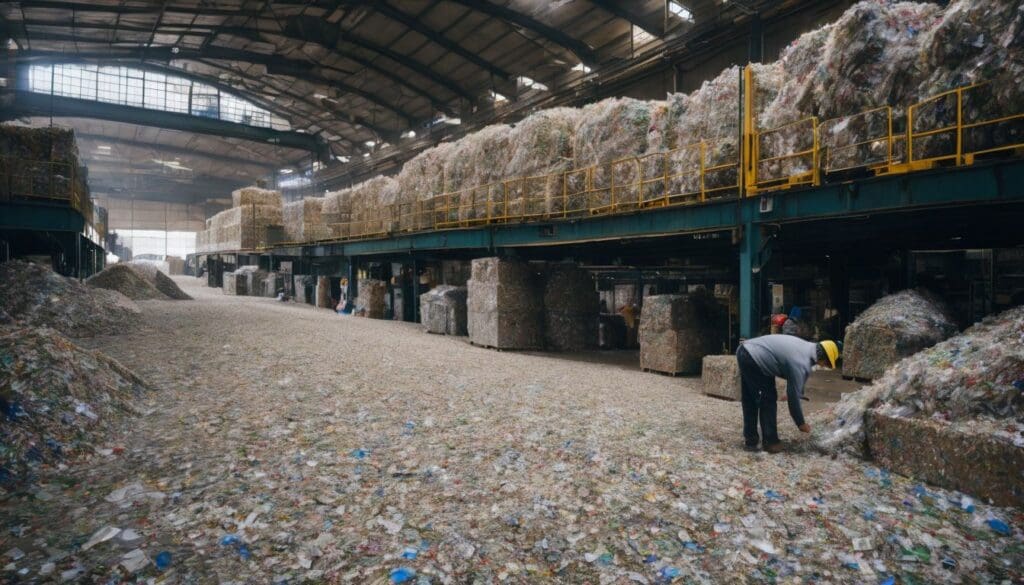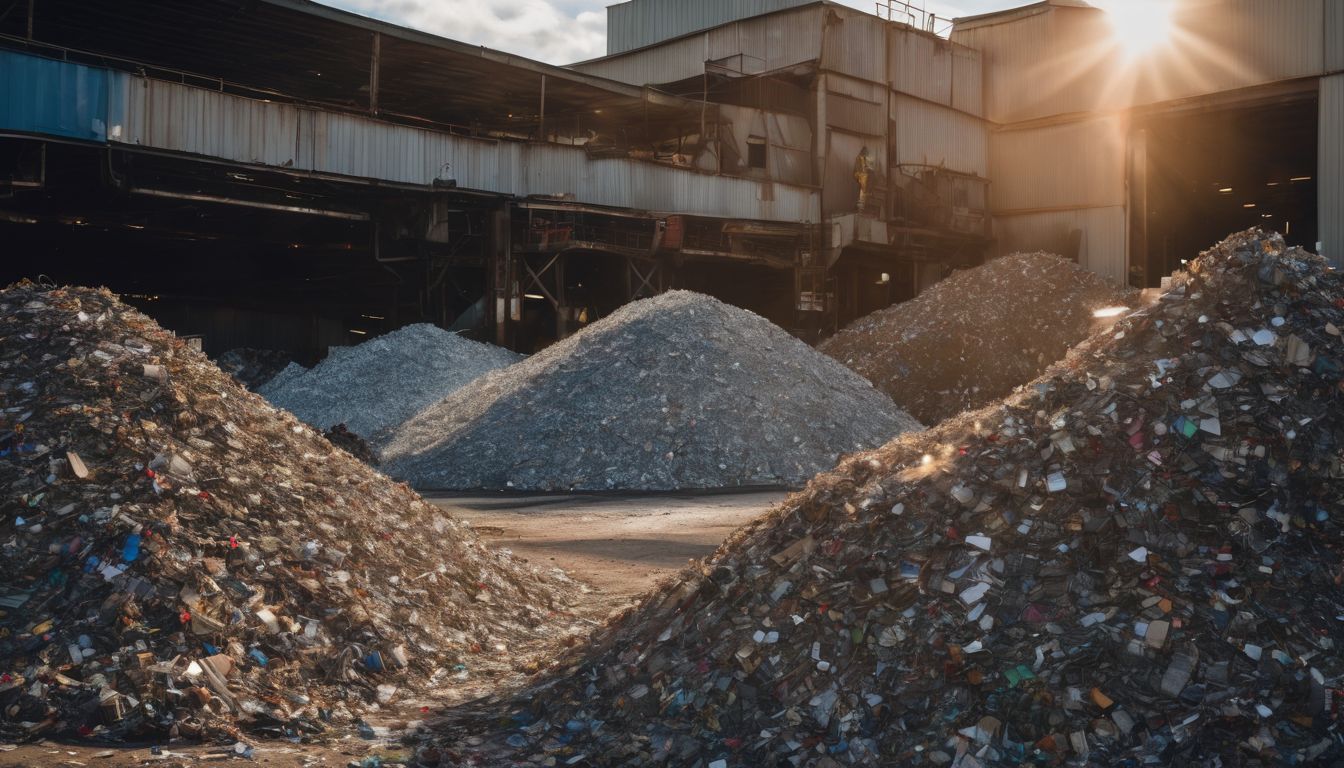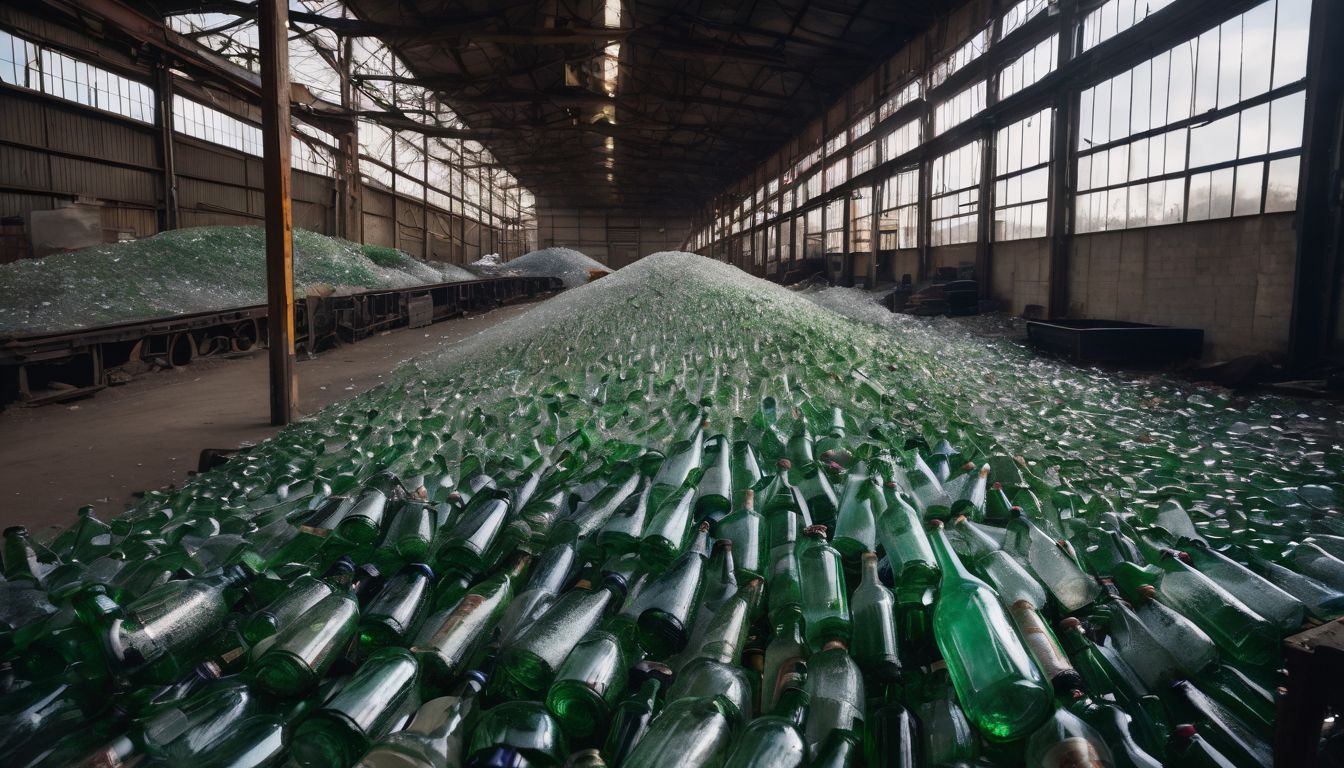Ever felt confused about what happens to your recycling after it’s collected? Every year, millions of tonnes of materials are saved from landfills through recycling. This article will explain the journey recycled goods take and why it matters for our planet.
Dive in to uncover a greener future!
Key Takeaways
- Recycled materials start as waste products, which are collected, sorted to eliminate contamination, and transformed into raw materials for new goods. This process conserves resources and reduces environmental impact.
- Advanced technologies in recycling facilities can effectively reduce waste contamination and improve the recycling process by separating different types of recyclable materials more accurately.
- Promoting circular economy practices is essential as it encourages keeping materials in use for longer periods by designing products that are durable and easy to reuse or recycle.
- Collaboration between industries plays a significant role in sharing best practices and innovative solutions to enhance the efficiency of recycled material management across various sectors.
- Proper disposal of recycled products after their use phase ensures they stay within the lifecycle loop, thereby minimising environmental damage and promoting sustainable resource conservation.
Understanding the Life Cycle of Recycled Materials
Recycled materials go through various stages including extraction of raw materials, processing, manufacturing, distribution, use and disposal. Each stage plays a crucial role in the overall sustainability and environmental impact of recycled materials.
Raw Materials
Raw materials are the building blocks of all recycled products. They come from items that people have used and discarded, ready for a second life. Extracting these valuable materials requires careful sorting to remove any contamination.
This ensures that the raw materials meet quality standards for their next phase in the recycling process.
The journey of sustainable materials begins with collection and extraction from waste streams. Paper, glass, metal, and plastic get separated and prepared for reprocessing. By choosing to reuse these resources, we conserve natural resources and reduce environmental impact.
Every tonne of recycled paper saves trees and cuts down on pollution—clear evidence that upcycling waste makes a real difference to sustainability efforts.
Processing
Processing recycled materials involves sorting, cleaning, and transforming them into new products. Machinery separates different types of materials such as plastic, glass, and metal for reprocessing.
Then, the cleaned and sorted materials are ready to be used in manufacturing new items. Through this process, waste is minimised while conserving natural resources like water and energy.
Next up: “- Manufacturing” where these reprocessed materials are formed into new products for use.
Manufacturing
Manufacturing recycled materials involves transforming raw recyclables into new products. This process typically includes sorting and cleaning the materials, melting or breaking them down, and then reshaping them into new items.
Technologies such as 3D printing are also playing a role in manufacturing with recycled materials, creating innovative sustainable products like packaging and building materials. Collaboration between industries helps to expand the use of recycled content in manufacturing, promoting environmentally friendly practices and reducing reliance on virgin resources.
Distribution
Manufacturers distribute recycled materials to various industries for reuse. They transport these materials to different locations using environmentally friendly methods, reducing carbon emissions and supporting sustainable practices.
This distribution process is crucial in ensuring that recycled materials are efficiently integrated into the production cycle, contributing to waste reduction and resource conservation.
After processing, manufacturers package the recycled products and deliver them to retailers and consumers. Eco-friendly packaging plays a key role in minimising environmental impact during transportation and promotes sustainable consumption practices.
Use
Following distribution, the recycled materials are then utilised in various ways. Manufacturers incorporate these eco-friendly resources into their production processes to create new products or packaging.
Consumers contribute by selecting and using recycled paper products, waste management practices, and sustainable material reuse techniques in their daily lives. By actively participating in the use of recycled materials, individuals can champion the cause of sustainable production and eco-friendly packaging.
Ecofriendly materials play a crucial role in reducing environmental impact and promoting a circular economy approach. Ultimately, supporting the use of recycled materials contributes to waste reduction efforts and fosters a greener planet for future generations.
Disposal
After using recycled materials, proper disposal is crucial to complete the lifecycle. Recycling extends beyond consumption and use; it involves responsible management of waste. Disposal methods vary according to the type of material – from composting organic matter to recycling paper and plastic.
Responsible disposal ensures that recycled materials remain in the loop, reducing environmental impact and conserving resources for future generations.
Understanding the best ways to dispose of different recycled materials is essential for successful resource conservation. It’s an integral part of upholding eco-friendly practices and ensuring that the cycle remains unbroken.
The Importance of Proper Recycling
Proper recycling is crucial for environmental benefits, reducing waste in landfills and conserving natural resources. It plays a significant role in sustainable living and reducing our carbon footprint.
Environmental benefits
Recycling materials offers significant environmental benefits, reducing the demand for raw resources and cutting down on energy consumption. By using recycled materials in manufacturing processes, we can lower greenhouse gas emissions and minimise air and water pollution.
Additionally, recycling helps to conserve natural habitats and protect wildlife by decreasing the need for mining or logging. Using eco-friendly packaging made from recycled materials also lessens the amount of waste that ends up in landfills, contributing to a cleaner and healthier planet.
The use of recycled materials also plays a crucial role in mitigating climate change. Reprocessing materials reduces carbon emissions associated with traditional production methods while promoting sustainable practices.
Reduction of waste in landfills
Reducing waste in landfills is a critical step that directly contributes to environmental preservation. By recycling materials, we lessen the volume of waste sent to landfills, thereby reducing the strain on these sites and decreasing harmful emissions from decomposing waste.
This process not only conserves valuable landfill space but also minimises the need for new disposal sites, contributing positively to our natural surroundings.
Minimising waste in landfills through proper recycling practices significantly curtails greenhouse gas emissions. By diverting recyclable materials from landfills, we can mitigate methane production and limit air and water pollution caused by traditional waste management methods.
Conservation of natural resources
Conserving natural resources is crucial for preserving the environment. Through proper recycling, we can reduce the demand for raw materials such as timber, water, and minerals. By reusing materials like paper, glass, and plastic, we can limit the depletion of these valuable resources.
Making environmentally conscious choices with eco-friendly packaging and supporting material reprocessing helps in the overall conservation of our planet’s precious natural resources.
Efficient recycling processes work towards a sustainable future by reducing the need to extract new resources from nature. This ensures that our ecosystems remain balanced and less impacted by human consumption.
Challenges in Recycled Materials Management
Contamination, lack of infrastructure, and the need for education and awareness are significant hurdles in managing recycled materials. Read on to learn more about how we can overcome these challenges to improve recycling practices.
Contamination
Contamination occurs when non-recyclable materials or substances mix with recyclables, making them unfit for further processing. This can happen at various stages of the recycling process, from collection to sorting and even during transportation.
Common contaminants include food waste, plastic bags, and non-recyclable plastics like polystyrene. When contamination is present in recycled materials, it reduces the quality and value of the end product, impacting its potential for reuse or remanufacturing.
To tackle contamination effectively, proper education on what can and cannot be recycled is essential. Clear labelling on bins and packaging can also help individuals dispose of items correctly.
Lack of infrastructure
Recycled materials management faces challenges due to a lack of infrastructure, hindering efficient collection and processing. Many areas still don’t have access to convenient recycling facilities, making it difficult for individuals and businesses to participate in the recycling process.
As a result, recyclable materials often end up in landfills rather than being reprocessed, contributing to environmental pollution. Enhancing infrastructure for waste management is essential to promote sustainable practices and reduce the strain on natural resources.
Moving forward with improving the Recycling Process – Implementation of technology offers potential solutions for these challenges by streamlining collection and sorting processes leading to more effective material recovery systems.
Education and awareness
Education and awareness play a crucial role in the successful recycling of materials. It is essential to educate individuals about the importance of proper waste management and recycling practices.
By increasing awareness, people can make informed decisions about their consumption habits, leading to a reduction in overall waste production. Educating communities on the benefits of using eco-friendly packaging and materials can also promote sustainable living practices.
Furthermore, raising awareness about the impact of recycling on conserving natural resources and reducing pollution is vital for influencing positive behavioral changes. Educational initiatives should highlight simple yet effective ways individuals can contribute to the conservation of natural resources through responsible material use and disposal.
Improving the Recycling Process
Implementing advanced technology in recycling facilities can help streamline the process and reduce contamination, while promoting circular economy practices can encourage the use of recycled materials in new products.
Collaborating between industries can also lead to more efficient recycling methods and reduce waste overall.
Implementation of technology
Implementing advanced technology in the recycling process has significantly improved efficiency and output quality. Innovative sorting machines equipped with artificial intelligence can accurately separate different materials, reducing contamination and increasing the value of recycled products.
Additionally, smart tracking systems allow for real-time monitoring of materials throughout the entire recycling chain, ensuring transparency and accountability.
Cutting-edge recycling technologies not only enhance the quality of recycled materials but also streamline the process, making it more cost-effective and environmentally friendly. For instance, state-of-the-art equipment such as advanced shredders and extruders can efficiently transform plastic waste into high-quality raw materials for manufacturing eco-friendly products.
Promoting circular economy practices
Promoting circular economy practices involves rethinking the entire lifecycle of products. This approach focuses on reducing waste and keeping materials in use for as long as possible, ultimately creating a more sustainable system.
By designing for durability, reuse, and recycling at the core of product development, companies can minimise environmental impact while maximising resource efficiency.
Encouraging circular economy practices is vital to conserving natural resources and reducing pollution. Businesses play a crucial role in this transformation by adopting eco-friendly packaging and materials, collaborating with other industries to promote recycling initiatives, and implementing innovative technologies to ensure that materials are kept within productive cycles.
Seeking out ways to close the loop on material usage is essential for creating a truly sustainable future.
Collaboration between industries
Industries collaborating to improve recycling processes can make a significant impact on the environment. By working together, they can develop innovative solutions for managing recycled materials more efficiently.
This collaboration encourages the exchange of best practices and technologies, contributing to a more sustainable approach towards waste management.
Engaging in partnerships amongst industries also fosters the development of eco-friendly packaging and materials, promoting the use of recycled resources throughout various supply chains.
Conclusion
In conclusion, understanding the life cycle of recycled materials is crucial for promoting a more sustainable future. Implementing technology and promoting circular economy practices are essential for improving the recycling process.
Collaboration among different industries is also key to ensuring that recycled materials management becomes more efficient and effective. With these efforts, we can work towards reducing waste in landfills and conserving natural resources.
FAQs
1. What is the lifecycle of recycled materials?
The lifecycle of recycled materials refers to the process where materials are collected, processed into new products, and then used again.
2. How does life cycle analysis impact recycling?
Life cycle analysis helps us understand the environmental benefits of using ecofriendly packaging and materials throughout their lifespans.
3. Why should we choose ecofriendly packaging?
Choosing ecofriendly packaging reduces waste and pollution, supporting a healthier environment as these packages can be easily recycled or decompose without harm.
4. Can all materials go through the recycling lifecycle?
Not all items are recyclable; however, many can be turned into ecofriendly materials that contribute to reducing our carbon footprint when properly disposed of and treated.





